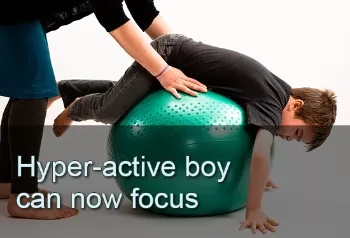Primitive Reflex Integration Case Studies
Hyperactive Boy Can Now Focus
4-year-old improves attention span, safety awareness, motor skills, and more.
This little boy was constantly distracted and bouncing off the walls, would crash through objects in the environment rather than walk around them, didn't show hand dominance or a proper grasp, and drooled. Using reflex integration techniques from the Brain and Sensory Foundations First Level course resolved all of these issues.
Submitted by Mansi Bhagwate, Occupational Therapist, MS OTR/L, CPH

| Before | After |
|---|---|
| Unable to focus | Can now stay on task for 10-12 minutes |
| Hyperactive | Calm and self-regulated |
| Showed no hand preference | Shows a hand preference with a proper grasp |
| Drooled when concentrating | No more drooling |
Adam (name changed) is a 4-year-old boy who I have been working with since December 2015 and introduced reflex integration [from the Brain and Sensory Foundations course] in March 2016. His mother reported that he is a hyperactive boy with a fleeting attention span. He is always on the go and is easily distracted by surroundings. He was born full term and his mother had an uncomplicated pregnancy, which is why she was surprised when he didn’t talk until he turned 3 and was "clumsy."
When I started working with him in December, I too noticed that he was hyperactive and needed a lot of sensory input in form of heavy work and brushing to help him focus for 1-2 minutes after which he was off again.
Safety was also one our concerns as he was literally bouncing off walls, sofa and TV in his "free" time. He could barely play with toys. He was so strong that sometimes he exerted too much pressure when playing or writing and would break things. He didn’t know how to approach peers or adults for play and ended up hitting them, fighting with them or having a tantrum. He didn’t show hand preference and switched hands all the time. He had a fisted grasp while coloring. Motor planning was also a problem as he couldn’t figure out an obstacle course and would just trample everywhere, all the while laughing. He also drooled quite a bit especially when concentrating on activities. He seemed to have a sensory processing disorder.
I first introduced P.A.C.E warm ups [from the Brain and Sensory Foundations course]. Immediately I noticed that he couldn’t do cross crawls and hookups, especially arm crossing. So we practiced passively. Next, we did the 4 basic rhythmic movements passively. I also had mom practice those on herself and on Adam. He kept on asking for more and we ended up doing those in the entire session. Immediately, he appeared calm and completed entire 6 piece puzzle by himself as I sat next to him, observing.
Next, I used the reflex pattern and rhythmic movement assessment [from the Brain and Sensory Foundations course] and found that he had at least TLR [Tonic Labyrinthine Reflex], Moro [Moro Reflex] and palmar/babkin reflexes still unintegrated. We then started doing isometrics for TLR. We also played neck flexion extension games like pushing balls back and forth etc. He loved participating in those games and also said he would play them with his cousin. He also really liked doing cat-cow poses. We continued with rhythmic movement.
"His attention span was now improving. He completed 3 desktop activities (cutting, tracing lines, play-doh) which lasted for 10-12 minutes, the most he has ever paid attention for anything."
He was still drooling when cutting, so I changed focus to integrating palmar/babkin. For the next few sessions we did brushing palms, isometrics, oral-strengthening exercises. In my last session, drooling wasn’t there anymore. It was more like a wet mouth. His mom reported that since she has been doing rhythmic movements with him, he has been sleeping through the night without waking up and didn’t fight with his cousin over the weekend. I noticed that he didn’t switch hands while writing/coloring and used his right hand with a 4 finger grasp. We have moved onto integrating the Moro as he tends to get scared with loud noises and sudden change of position. He loves doing Roly-Poly, jelly fish and monkey hugs with a body pillow. I also use therapeutic listening with him when we do Moro integration.
Since March 2016, I have completed at least 6 sessions with Adam with rhythmic movements, isometrics for TLR, palmar/babkin, Moro and PACE tune ups.
"I am noticing a drastic change in this boy’s demeanor. Where at first, I saw an immature, hyperactive boy with a lack of safety awareness and delay, today I see a calm, self-regulated child who follows adult directions, completes activities asked of him, shows an active interest in academic activities, can sit down for task completion, is showing a hand preference with a proper grasp and doesn’t drool anymore when concentrating.
He has come a long way in a short time.
[Edited for length and clarity; emphasis added]
*Disclaimer: The activities in the Brain and Sensory Foundations curriculum make use of the natural processes of neuroplasticity and development that are innately wired in the design of human beings to promote maturity and function. These activities appear to calm, organize, and mature the neuro-sensory-motor systems just as we see in the healthy development of human infants. Individual results may vary, and we do not claim to offer a diagnosis or cure for any specific condition or disorder. The Brain and Sensory Foundations activities appear to improve overall functioning resulting in measurable improvements for a range of conditions as demonstrated in over 1800 case studies from participants.

